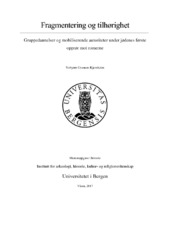| dc.contributor.author | Kjersheim, Vebjørn Granum | |
| dc.date.accessioned | 2017-09-07T07:24:29Z | |
| dc.date.available | 2017-09-07T07:24:29Z | |
| dc.date.issued | 2017-06-17 | |
| dc.date.submitted | 2017-06-16T22:00:10Z | |
| dc.identifier.uri | https://hdl.handle.net/1956/16579 | |
| dc.description.abstract | The subject of this paper is the first Jewish war against the Romans. In particular, it aims to explain why the revolt lasted for as long as it did, and how it became so grievous. When looking at the main source for the rebellion, the ancient historian Josephus Flavius, he claims that some few insurrectionist groups are to blame. This claim has been challenged by several historians, and rightly so. The actions of separate groups have been studied to explain their relevance to the rebellion. Religion and a common Jewish identity have been deemed to be the main factors for why the revolts became so grave. However, this might not explain everything. Thus, the thesis statement of this paper is that the populace in the Roman region of Judaea was fragmented to such a degree that when war broke out, peace could not easily be achieved by either the Romans nor the Jews. In order to prove this thesis, the different components of the populace must be studied in light of the conflict. The various components are seen through groups and factions, but also leaders and their authorities. By using Fredrik Barth’s social anthropological theories, one can see the relationship between different groups as defined by their differences. Groups can be categorised by their goals and functions. For instance, the Pharisees, Sadducees and Essenes are more philosophically oriented groups, but they also served as interpreters of the law, and they influenced the populace of Judaea through their networks. The mystical fourth philosophy is considered to be a coherent group by many historians, but this view is challenged in this paper. I claim that it should be seen more like a contemporary influence which later was defined through the sources. Zealots and sicarri formed groups who might show some of the influence from the fourth philosophy through their goals. There are also other divisive aspects to consider besides the religious and political aspects. Hellenistic cultural influence is also an important factor and shows differences between elite culture and the masses. Cultural, as well as social aspects, can be seen through family units and how they projected their identity through their household, as well as through customs such as marriage. Economic factors separated residents in the city and the countryside, while bandits and raiders enhanced these differences. The many and very different leaders also represented a large number of groups, which further shows a trace of a fragmentation of the populace. Josephus defines some of these groups, and some are defined through interpretation of the different layers in the society described in the sources. | en_US |
| dc.language.iso | nob | eng |
| dc.publisher | The University of Bergen | eng |
| dc.subject | jødiske opprør jødiske krig jøde fariseer saddukeer esseer den fjerde filosofi ledere mynter prutah shekel sheckel jewish war rebellion revolt romerne Roma Vespasian Titus Josefus Josephus Flavius jøde jew Johannes Giskhala Simon Gioras Eleazar Fredrik Barth sosialantropologi judeer Judea Judaea Ioudaios Den jødiske krig Jødenes gamle historie antikken Mot apion Josefus' liv max weber autoritet kilde seloter selot sikariere sikari hellenisme hellenistisk banditter røvere familie ekteskap segregering ledere sjarlatanen Masada Jerusalem Titus Agrippa profeter karismatisk legal tradisjonell fragmentering og tilhørighet | eng |
| dc.subject | jødiske opprør jødiske krig jøde fariseer saddukeer esseer den fjerde filosofi ledere mynter prutah shekel sheckel jewish war rebellion revolt romerne Roma Vespasian Titus Josefus Josephus Flavius jøde jew Johannes Giskhala Simon Gioras Eleazar Fredrik Barth sosialantropologi judeer Judea Judaea Ioudaios Den jødiske krig Jødenes gamle historie antikken Mot apion Josefus' liv max weber autoritet kilde seloter selot sikariere sikari hellenisme hellenistisk banditter røvere familie ekteskap segregering ledere sjarlatanen Masada Jerusalem Titus Agrippa profeter karismatisk legal tradisjonell fragmentering og tilhørighet | eng |
| dc.subject | jødiske opprør jødiske krig jøde fariseer saddukeer esseer den fjerde filosofi ledere mynter prutah shekel sheckel jewish war rebellion revolt romerne Roma Vespasian Titus Josefus Josephus Flavius jøde jew Johannes Giskhala Simon Gioras Eleazar Fredrik Barth sosialantropologi judeer Judea Judaea Ioudaios Den jødiske krig Jødenes gamle historie antikken Mot apion Josefus' liv max weber autoritet kilde seloter selot sikariere sikari hellenisme hellenistisk banditter røvere familie ekteskap segregering ledere sjarlatanen Masada Jerusalem Titus Agrippa profeter karismatisk legal tradisjonell fragmentering og tilhørighet | eng |
| dc.title | Fragmentering og tilhørighet - Gruppedannelser og mobiliserende autoriteter under jødenes første opprør mot romerne | eng |
| dc.title.alternative | Fragmentation and affiliation - Group formation and mobilizing authorities during the Jews' first revolt against the Romans | eng |
| dc.title.alternative | Fragmentation and affiliation - Group formation and mobilizing authorities during the Jews' first revolt against the Romans | eng |
| dc.title.alternative | Fragmentation and affiliation - Group formation and mobilizing authorities during the Jews' first revolt against the Romans | eng |
| dc.title.alternative | Fragmentation and affiliation-Group formation and mobilizing authorities during the Jew's first revolt against the Romans | eng |
| dc.type | Master thesis | |
| dc.date.updated | 2017-06-16T22:00:10Z | |
| dc.rights.holder | Copyright the author. All rights reserved | eng |
| dc.description.degree | Historie mastergradsoppgave | |
| dc.description.localcode | MAHF-HIS | |
| dc.description.localcode | HIS350 | |
| dc.subject.nus | 713107 | eng |
| fs.subjectcode | HIS350 | |
| fs.unitcode | 11-22-00 | |
